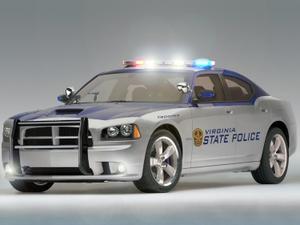Ford faces competition for next-generation cruiser
Ford has long dominated the police car market with about 70 percent of the 75,000 police cars sold annually; the Dearborn automaker, however, will stop producing the Crown Victoria next August and is replacing it with the far more modern Police Interceptor; Ford is facing competition from a redesigned Dodge Charger Pursuit police car and the return of the General Motors’ Chevrolet Caprice police car

Dodge Charger Pursuit - chasing the Ford Interceptor // Source: blogspot.com
A crop of new police cars drew more than 400 law enforcement officials to Chrysler’s proving grounds in Chelsea Saturday to see the Michigan State Police put the cars through acceleration, braking, high-speed handling, and other tests.
While rain forced the police to suspend testing this morning, Ford, which has long dominated the police car market with its rear-wheel drive Crown Victoria, was working hard to overcome skeptics as it introduced a front-wheel drive Police Interceptor based on the Ford Taurus.
“They will have a tough time,” said Terry Sweezey, public safety officer from Leoni Township. “It is a whole different driving system.”
Detroit Free Press’s Brent Snavely writes that Ford has long dominated the police car market with about 70 percent of the 75,000 police cars sold annually. The Dearborn automaker, however, will stop producing the Crown Victoria next August and is replacing it with the far more modern Police Interceptor. The new car has a 3.5-liter V6 engine with an estimated 280 horsepower or a turbocharged 3.5-liter V6 engine with an estimated 365 horsepower(see “Ford continuing launch schedule of new police-spec vehicles,” 7 September 2010 HSNW).
Ford faced competition Saturday from a redesigned Dodge Charger Pursuit police car and the return of the General Motors’ Chevrolet Caprice police car.
Both the Charger and Caprice are rear-wheel drive cars and the Caprice was the market leader before GM discontinued it in 1996. Rear-wheel drive cars are preferred by police departments because they tend to be more durable, are cheaper to repair, and make it easier to perform high-speed maneuvers.
“We drove Caprices for many, many years…so with Chevy coming back in with the rear wheel-drive Caprice, we are definitely very interested,” said Marlyn Dietz, a captain with the Wilmington, Police Department.
The Caprice’s 6.0-liter V8 is rated at an estimated 355 horsepower. Dietz said his department also likes the extra space provided by the Caprice. The Caprice has 122 cubic feet of interior space, which GM says is more than any of its competitors.
“That’s a big deal. When you have two big guys in a car, with a laptop, and you need to have room for them to move around and function,” Dietz said.
Space and comfort are also important because officers spend hours inside their cars every day, he said.
Tony Gratson, sales manager for Ford’s government fleet vehicles, said the performance through curves and in bad weather of the all-wheel drive version of the Police Interceptor is actually better than rear-wheel drive vehicles. Still, he conceded many officers will need additional training to make the transition. “And we will be prepared for that. We will help them train as we launch our vehicles next year,” Gratson said.
Eugene Mitchell, senior manager of government fleet sales for Chrysler, said the 2011 Dodge Charger Pursuit has 15 percent more visibility than the outgoing version because of an adjustment to the angle of the windshield. It also has 3.6-liter V6 engine with 285 horsepower that has 30 more horsepower than the outgoing version or a 5.7-liter V8 engine with 360 horsepower.
Jerry Newbury, fleet operations manager for the Texas Department of Public Safety, said Ford’s decision to end production of the Crown Victoria is ushering in a wave of innovation in police cars that was long overdue.
“They were very stale, very outdated and technology had not kept up,” Newbury said of the previous police cars. “I think there are some things coming in the next two or three years that are really going to change the police business.”
Preliminary results from three-day tests hosted by the Michigan State Police are expected in several weeks and final results are scheduled to be published in December.
